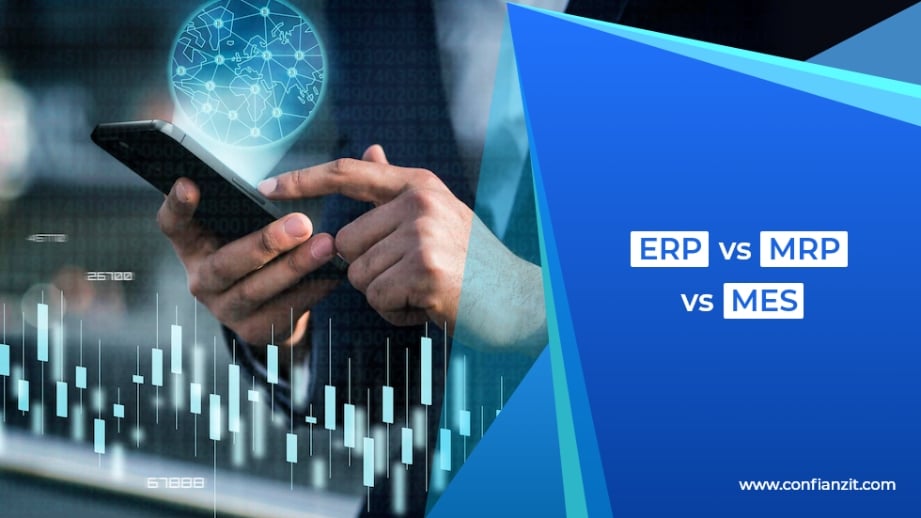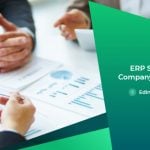The business world loves acronyms. And if you’re starting or maybe curious about the technology that could increase your productivity and improve your bottom line, it’s easy to get lost in the acronyms.
Do you need an ERP? An MRP or MES? Or maybe even all three?
That’s why we’re going to go through and define each of these and give you an idea of whether or not it’s something you should look at investing in.
What Is an ERP?
We have a dedicated article if you’re looking for a more in-depth exploration of ERPs and why you may need one. But this is a brief explanation.
ERP (Enterprise Resource Planning) is a software application that integrates all the resources and connects all departments within an organization. It combines information from different departments, such as HR, finance, sales, marketing, etc., to help managers and organizational leaders make decisions about their business operations more efficiently.
ERP systems can allow companies to manage their entire supply chain in real-time by tracking several departments, including procurement, manufacturing, distribution, and service delivery processes. This helps businesses increase overall profitability by improving productivity, reducing costs, and boosting customer satisfaction.
Why you might need an ERP
There are many reasons why you might need an ERP system for your business, and those reasons will change depending on what industry your company operates in.
In general, ERPs are used by organizations to provide better customer service, improve operational efficiency and accuracy, and simplify business processes. How that looks exactly will vary from one company to another.
For example, in an e-commerce business, an ERP can help you manage your inventory, track shipments, and ensure that everything is adequately stocked in multiple warehouses.
Another way an ERP can help you is to ensure that your employees are working efficiently. By having access to all company information, employees will not waste time on a task they could complete in half the time if they had more information at their fingertips. Additionally, they will not repeat work that someone else has already done.
Since ERP systems are so flexible, businesses in almost every industry can benefit from them to improve communication and efficiency across their entire organization.
What Is an MRP?
MRP is an acronym for Material Requirements Planning. It is a system that integrates the various functions of a manufacturing company, such as production, distribution, and inventory management.
The concept of an MRP system has been around since the 1950s and has been used in various industries to help improve efficiency. It is principally used to optimize production and inventory levels by managing materials, production, and work orders.
The MRP system takes data from various sources, such as suppliers, production planners, and salespeople, to generate an accurate plan for the manufacturing process.
The MRP system is made up of three major components: the master production schedule (MPS), the material requirements planning (MRP), and the bill of materials (BoM).
Why you might need an MRP
MRPs were initially produced to fit the needs of engine makers like Rolls Royce, and they’re uniquely made to address the needs of manufacturers. They are used in many industries, including electronics, automotive, and food. Manufacturers have realized the importance of MRPs and are using them to increase their profitability.
Some things MRPs do include:
- Reduce the cost of goods sold
- Provide detailed analysis of the sales, production, and inventory.
- Assist in maximizing resource use, including labor, materials, equipment, and space.
- Support integration with other systems like ERP or CRM, which the company is already using.
- Help companies plan their production schedules based on their demand forecasts.
What Is an MES?
An MES (Manufacturing Execution System) provides real-time data and analytics on manufacturing processes to optimize them and make them more efficient. An MES also helps reduce errors and improve the quality of products.
MES systems are mainly used in manufacturing environments. The primary purpose of an MES is to gather, analyze, and process data from different sources. This information can then be used to decide how to improve the production process.
The MES is usually installed on a server or as an application on a PC or laptop. It communicates with sensors throughout the plant. The sensors collect data and transmit it wirelessly to the MES server every few seconds. The software then analyzes the data to provide information about current production rates, machine uptime, and other valuable statistics for manufacturing operations management purposes.
An MES system provides a complete view of the manufacturing shop floor, from order entry to production and engineering change orders to inventory.
Why you may need an MES
MES systems combine different departments’ workflows and provide a cohesive, unified view of the production process.
The benefits of an MES system are many, including:
- Better collaboration between different departments
- Improved visibility into production processes
- Increased efficiency and productivity
- Reduced costs
MES systems can also be used in conjunction with ERP systems for better management of resources.
Manufacturers use an MES to improve efficiency, reduce waste and quality, and monitor production for better forecasting.
Which Is Right for You?
All these different solutions have their place in the business world. They can all work independently or in conjunction, so keep that in mind.
If you aren’t in manufacturing and don’t deal with raw goods (or only do so to a minimal extent), your best bet is an ERP to handle your accounting, human resources, business operations, and whatever else you need.
If your business involves a lot of supply chains—especially long supply chains—and inventory management, an MRP is the best decision.
MRPs and MESs work very well together if you’re dealing with machinery and need to know how many works in progress you have.
Picking and choosing between different solutions can be tricky, which is why Confianz is here to help! Our team can help you construct the perfect system for your business so you can bring your productivity to another level.
We are partners with both Odoo ERP and Acumatica ERP, so we can help you with every step, from deciding which ERP to use to implementing it, training your team, and troubleshooting after launch. Acumatica Cloud ERP is a complete ERP solution for all type of business. Acumatica pricing model is flexible. It’s monthly fees fall in the range of $1,400-$2,800. Whereas, Odoo is a cloud-based, open-source ERP software that offers all the features of enterprise resource planning, CRM, and e-commerce. The company has been around for more than a decade.
So call us today for either Odoo ERP Implementation or Acumatica Implementation.







